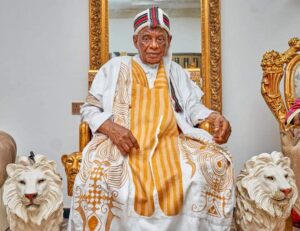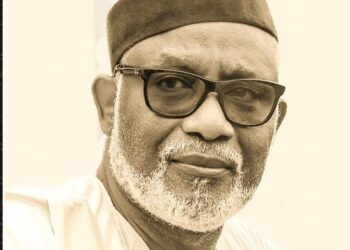The death of His Royal Highness the Ohinoyi of Ebiraland, Dr Ado Abdulraman Ibrahim, today, drew me back to go through the biography of his father, Alhaji Ibrahima Onoruoiza, of blessed memory.
The book, titled ‘Has History Been Fair to the Attah?: A Biography of a Powerful African Ruler South of the Sahara’, was authored by Dr. Habibu Angulu Sani, an excellent academic, administrator and writer, and was published by Desmond Tutu Publishers, Okene, in 1997. The author himself gave me an autographed copy on August 13, 1998 in my office. He had just obtained a PhD from Obafemi Awolowo University, Ile-Ife, and was my acquittance in Kaduna at the time (we used to meet occasionally). He it was who told me that Ebira women were the most beautiful women in Nigeria and seriously challenged me to prove otherwise. Of course, I didn’t, he being my elder, and I ensured that I included that assertion in my review of the book in the New Nigerian newspaper shortly after he gave me the book of 236 pages, which I have been keeping in my library for 25 years.
Alhaji Ibrahima Onoruoiza Ochogudo was the most notable Atta (i.e. Chief, a title borrowed from the neighbouring Igalaland) of Ebiraland and progenitor of the influential Atta dynasty, who ruled for 37 years (1917-1954). Dr Sani released it shortly after the appointment and official installation of one of the Atta’s children, Alhaji (Dr) Ado Abdulraman Ibrahim, as the new paramount ruler of Ebiraland some 43 years after his father’s reign (with the title of Ohinoyi, which his predecessor, Alhaji Mohammed Sani Omolori, first used). Sadly, it was Dr Ado who died today, aged 94, after ruling for 26 years.
This book is a valuable source of the history of not only the powerful Ebira king of the colonial era but also of the Ebira people (known previously as Igbirra). Dr Sani spent 15 years researching it, using primary sources including written ones such as colonial and post-colonial records, theses, books, as well as interviews with people in the know (most of whom are deceased now), etc. He traced the history of the Ebira people and tells us about the tribal wars they engaged in, especially against the Fulani-Jihadist conquerors, their migration from Kwararafa in present-day Taraba State and dispersal to their current locations in central Nigeria, customs, Igbo-like clan-concentrated political system, ethnic grouping, pagan religion, conversion to Islam and Christianity, pacification by the British colonialists, as well as post-colonial administrative system and relationship with other tribes, among others.
Of course, the central theme of the book is the Atta Ibrahima’s life and rule. Most of the space is therefore dedicated to his background, ascension to the throne, tenure as Chief of the Ebira under the Indirect Rule system, accomplishments, extended family, political struggles and the controversies that led to his removal and exile by the Governor of the Northern Region, Sir Sharwood-Smith. It also renders an insightful account of the contemporary tribal politics in Kogi State. The book is illustrated with many relevant photographs.
In it, one also gets to read about the Atta’s 148 children, many of whom were amongst the who-is-who in the post-independence era in the country. Examples: Abdulmalik, the first son (the first Nigerian Ambassador to the UK, a position he held for 15 years, and later the Nigerian Ambassador to France); Abdullahi (first Nigerian Ambassador to Cuba, and then to Canada); Abdulmutallib (sales manager at Shell Oil); Aliyu (Inspector General of Police); Mahmoud (protocol officer to Sir Ahmadu Bello, Premier of Northern Region, and later the billionaire owner of the famous MIA Group of Companies); Adamu (Governor, Ƙwara State); Abdul’aziz (Permanent Secretary, Federal Ministry of Finance when Awolowo was the Minister, and later Secretary to the Federal Military Government under General Gowon), Abdulmalik (Legal Adviser to OPEC), Abdulmumini (a doctor who served as Chief Medical Officer of the Northern Region and later the Secretary to the State Government, North-Central State); Shehu (a soldier who fought in World War II and who, upon retirement, became the District Head of Okene and later the confidante/companion of his father in exile), and of course Ado, the Ohinoyi who has just passed on, among others.
Many of the Atta’s 26 daughters have also achieved quite a push up the ladder. For example, Rakiya was the first Nigerian Ambassador to Greece; Ambassador Katsina was the First Lady of the Western Region when her husband, Dr Moses A. Majekodunmi, held the region briefly after the assassination of the Premier, Chief Akintola; Judith was Nigerian Ambassador to Italy, Cyprus, and Greece; Kuriyetu, Medina, Raliat, and others were all top government officials at state or federal levels.
The secret to the children’s phenomenal rise to the top was education; they were all made to go to school by their father, the primary school having been located in the courtyard of his palace. The Atta believed seriously in education, both secular and religious, hence the comparatively high educational progression of his people and their dominance of key sectors in spite of their number compared to the so-called three major tribes in Nigeria.

From this book, one learnt that the late Ohinoyi, Ado, was a very successful business man when he vied for the stool of his father and won. In fact, he was one of the richest men in the country. But he had worked hard to become rich and never got anything on the platter of gold in spite of his royal background. He was a philanthropist per excellence. His donation of one million pounds to the Association of Commonwealth Universities in 1987 (ten years before becoming the Ohinoyi) was probably the biggest cash donation ever made by an individual Nigerian as at that time.
The book contains many anecdotes, which help to illuminate the narrative. Even though some people had tried to stop Dr Habibu Angulu Sani from writing it, one is glad that it was actually written. Now it counts as one of the major sources of the history of the peace-loving, hardworking and beautiful Ebira people.
I don’t know if it is still available for sale, nonetheless I recommend it to the general reader, academics, and government officials who seek additional knowledge about one of the most significant people residing in Nigeria. If it is no longer in print, those responsible should rise to the occasion and make it available.
May the souls of the late Ohinoyi, who was buried this afternoon, and his predecessors rest in peace, amen.
On a final note, I lost touch with Dr Habibu Angulu Sani many years ago. How I wish someone could tell me where he is now. I hope he is in good health and doing well.
Postscript:
This morning, I received the sad news from Hajia Zainab Suleiman Okino (after she read my article) that Dr Habibu Angulu Sani is actually deceased. I learnt that he passed on to the great beyond about ten years ago. That explains the deep silence from his end, and I am saddened to know about his passing only today. May Allah forgive his shortcomings and reward him with Paradise, amen.





